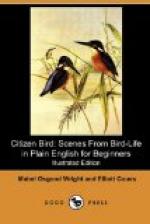“No,” said the Doctor, “this sturdy bird lays eight or ten white eggs with brown spots.”
“Ten eggs!” cried Dodo. “How can it sit on them all at once and keep them warm enough to hatch?”
“Perhaps the birds stir the eggs up every day to give them all an even chance,” said Rap.
“It is possible that they may,” said the Doctor; “but that is one of many things about home life in Birdland that we do not know.
“There is one thing more that I must tell you here, lest you make a mistake about the Golden-crowned Kinglet. He has a twin brother, so much like himself that their own parents can hardly tell them apart without looking at the tops of their heads. The other twin’s name is Ruby-crown, for he has a beautiful little crest of that color, half hidden in dark greenish; but not any of the black and yellow marks on the head that will always enable you to recognize the Golden-crown, if you can get a chance to see them while the little fellow is fidgeting about. It is a snug family that contains these two birdlets, for there is only one other member of it in all this part of the world, and you will not be likely to see him about Orchard Farm.”
The Golden-crowned Kinglet
Length four inches.
Upper parts olive-green, browner on the wings and tail, which have some yellowish edgings.
A bright-red stripe on the crown, bordered by a yellow and then by a black line; but young birds and females have only the yellow and black stripes, without any red.
Under parts soiled white, without any marks.
A Citizen of the United States, and a Tree Trapper.
THE WHITE-BREASTED NUTHATCH
“‘Yank! yank!’ says the White-breasted Nuthatch, as he runs up tree-trunks and comes down again head foremost, quite as a matter of course.
[Illustration: White-Breasted Nuthatch.]
“At first, or from a distance, you may mistake him for his cousin the Chickadee, who wears clothes of much the same color and is seen in the same places; or perhaps for the little Downy Woodpecker, who also hammers his insect food out of the tree bark.
“But at a second glance you will find the Nuthatch is very different. He keeps his body very close to the tree and uses his feet to creep about like a mouse or chipmunk; he also goes upside down, in a way that Woodpeckers never do, clings to the under side of a branch as easily as a fly to the ceiling, and often roosts or takes a nap head downward on the side of a tree-trunk—a position that would seem likely to give him a severe headache, if birds ever have such things.”
“This is the bird I saw the first day I went to the orchard with Olive; but why is he called a Nuthatch?” asked Nat.




